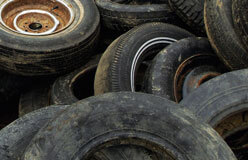Imagine stepping onto wet cement.
As you step, you leave a footprint that remains long after the cement has hardened. You may never have left a footprint in wet cement, but all of us leave footprints. The footprint we’re talking about here is the effect you have on the world’s resources. It is shaped by what you do, what you eat, where you go, and how you get there. You can help conserve resources by leaving as small a footprint as you can.
Your carbon footprint is the amount of carbon dioxide released into the atmosphere as a result of your actions. For example, when you ride in a car, you add to your carbon footprint. That’s because the fumes a car’s engine emits are mostly carbon dioxide. When you walk or ride a bike, you do not add to your carbon footprint. If you take mass transit, your carbon footprint is much smaller than if you ride in a car.
The trouble with adding to your carbon footprint is that carbon dioxide traps the Sun’s heat and is the main cause of climate change. Climate change leads to changes on Earth that can cause droughts, floods, habitat loss for plants and animals, and a rise in sea level.







